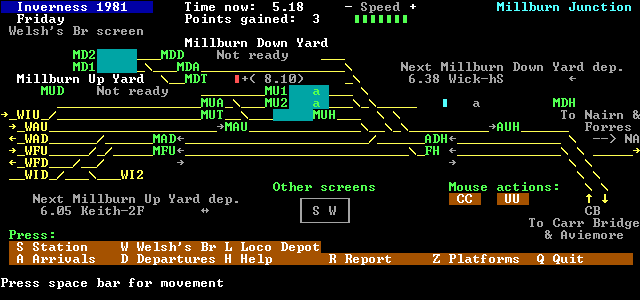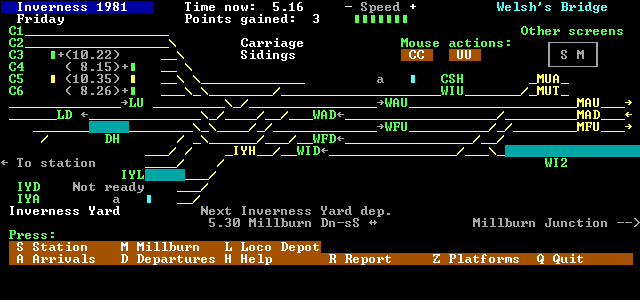|
One more screen than the 1970 version, as the growth of North Sea oil traffic increased the demands on Inverness TMD. There are a few through freights, but all scheduled passenger trains terminate at Inverness, which is mainly operated as two stations side by side, one for the north and one for the south and east. Freight traffic included is substantial, particularly on the Perth main line. You have a full 24 hour shift to operate, though it gets quiet at times. The diesel depot is on the site of the former Lochgorm Works, and has a lot to do. Some track simplification had taken place, including singling of the Forres line. The passenger service to Aberdeen had reverted to loco haulage, and the increased traffic had brought an increase in the number of sleeper and Motorail services, as well as extra freights.
|
|
This simulation is set at Inverness on a weekday in the summer of 1981.
The original Highland Railway main line to Forres via Nairn leaves to the east, continuing to Keith and Aberdeen; this line was single as far as Nairn (15 miles from Millburn). The continuation of the old main line from Forres on to Aviemore was closed to through traffic in 1965. Through traffic to Perth and the south now travels over the cut-off line from Millburn Junction via Carr Bridge and Slochd Summit to Aviemore, continuing over Druimuachdar Summit to Perth for Glasgow, Edinburgh and the south.
The line to the north first heads west to Lentran Loop along the southern shore of Inverness Firth, before heading north to Dingwall, where the Wick and Kyle lines diverge. A distillery is located at Muir of Ord, just north of Lentran. Other local freight services serve the Inverness Harbour Branch.
All freight traffic terminates or originates at one of the two main yards, Millburn Up and Millburn Down, situated between Millburn Junction and Inverness. In the main each yard handles traffic in the direction indicated by its name, though some up local traffic uses Down Yard. There are through and pick-up freights on all routes; in addition, there are trip freights connecting Inverness Yard and Inverness Harbour with Millburn Down Yard. Some through freights pause for a crew change and sometimes for traffic purposes in Millburn Up or Down Yard, or occasionally on the Rose Street curve.
As well as scheduled freights, there may be extras. At this time the most likely source of these were the British Aluminium smelter and the North Sea oil industry construction base, both at Invergordon, for which extras may come from various places. In this simulations some of these extras may run at higher difficulty levels.
You are responsible for all traffic in the area from Millburn Junction in the east to just west of Inverness station in the west, a distance of about 2 miles. Within this area there is little chance for high speeds, so in this simulation all movements are broadly the same speed.
You have to direct all the trains into, through and out of the area, selecting platforms and yard tracks to avoid delays and minimise congestion; you also have to manage the diesel depot, and ensure that locomotives are refuelled and that each train has suitable motive power.
The simulation is based on the scheduled service operating in the summer of 1981, with some conditional and extra freight services appearing at higher difficulty levels. For some added realism, some arriving trains will be late, and locomotives will occasionally need attention in the depot before further use. Occasionally a locomotive needing repair may arrive. Some simplification of the track plan has been necessary, particularly of the freight yards. The locomotives and units that will be present are those which were at the relevant depots at this time, and of classes that were observed on similar workings.
|
| Difficulty Level : | 
| | Price : | 
| | Genre : | Silver Series Large Terminus
| | Last Updated : | 14th December 1995
| | Locomotives/Stock Used : | 08, 20, 25, 26, 27, 37, 40, 47, 47/4
| | Simulated Time : | 24 hours
|
|



